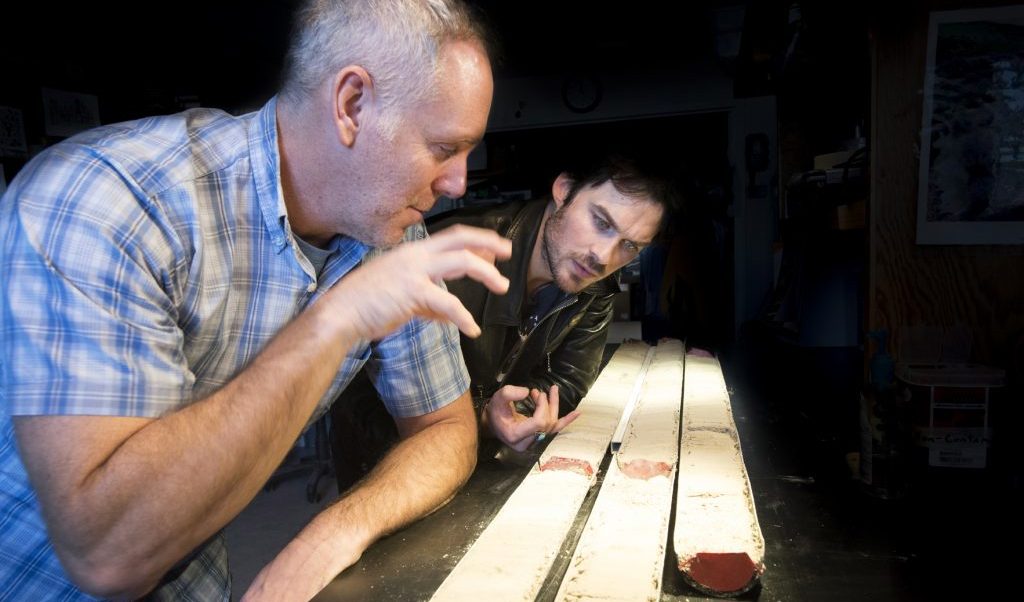Sediment Cores Hold Clues to Past Climate

June 1 marked the start of the Atlantic hurricane season. After last year’s extremely active and costly hurricane season, many are asking whether ocean warming, sea-level rise, and climate disruption are signaling a new, more intense hurricane regime. Should we in the Northeast do more to prepare for powerful hurricanes?
To know what to expect, we look to the past. But our instrumental archive of hurricanes dates back to just 1851. It shows southeastern New England has not experienced hurricanes of Category 3 intensity or higher. But are storms of that magnitude possible here?

WHOI scientist Jeff Donnelly and co-workers are reconstructing past storm activity on Cape Cod from clues stored in the sediments of Salt Pond in Falmouth, Mass. Photo by Ken Kostel/WHOI.
Dr. Jeff Donnelly, a scientist at the Woods Hole Oceanographic Institution, has been working to extend the record of past hurricanes in the western North Atlantic and Caribbean by looking at sediment cores. Donnelly’s team extracts the cores from isolated basins where sediments accumulate continuously and are vulnerable to hurricane-induced waves and currents. In the Caribbean, he takes cores from so-called “blue holes” – deep depressions in the seafloor where sediment funnels in and settles, becoming trapped and undisturbed by subsequent extreme events.
In the Northeast, Donnelly has been taking cores from Salt Pond in Falmouth, Mass., a brackish coastal pond with a 3-foot high coastal barrier between it and the ocean. During powerful storms, waves wash over the barrier, carrying large amounts of gravel and sand into Salt Pond that are distinct from the otherwise fine-grained sediment that normally settles there. It is these sandy layers that become a marker of the storm that can be seen in the sediment record.
With Woods Hole Sea Grant funding, Donnelly extracted six cores from Salt Pond and used them to reconstruct a 2000-year history of past storms, and, significantly, to infer the intensity of those storms on the Saffir-Simpson Hurricane Wind Scale.
“Hurricanes of greater intensity than have been experienced in recent history are possible here in southeastern New England,” says Donnelly. In fact, “the cores provide the first evidence of strong Category 3 and perhaps even Category 4 hurricanes in this region over the past 2000 years.”

Sand fraction of event bed dating to the 9th century CE (top) and 8th century CE (bottom). The event bed deposited ca. 780 CE is significantly coarser consistent with a heightened wave heights with a catastrophic hurricane. Black bar = 1 mm. Image courtesy J. Donnelly.
To reach this finding, Donnelly looked for unusual deposits of large-grained material -- “event beds” -- amidst the layers of mud in the cores. Donnelly observed 29 hurricane event beds in the Salt Pond cores, and matched a number of them to historic storms of known intensity. Several of the event beds Donnelly studied were significantly coarser than the remainder of the deposits and coarser still than those known storms – data that helped inform the conclusion that strong Cat 3 and 4 storms have occurred in this region in the past.
“By looking at how grains were sorted during those events and using inverse modeling, were able to determine the relative local magnitude of storm waves and sustained wind speeds from the event’s deposits dating back 2000 years,” Donnelly says.
Donnelly and his team have done a lot of outreach to educate others about their research methods and findings, including participating in documentaries for the PBS series NOVA and for Showtime’s Years of Living Dangerously.

Donnelly with Ian Somerhalder during production of the documentary Years of Living Dangerously. Photo by Tom Kleindinst/WHOI.
“Using sediments hidden beneath our coastal ponds, Donnelly and his team are not only painting a picture of the past, but also helping improve understanding of what the future may hold in a changing climate,” says Sea Grant Director Matt Charette. “This is information that is critical for everyone from local residents to emergency planners and municipalities to insurance companies.”
Getting scientific information into the hands of end users so they can make informed decisions a central part of Sea Grant’s mission. Donnelly agrees, adding, “What makes Sea Grant unique is that it facilitates the transfer of scientific results so that people can use it. And it provides a great opportunity to support fundamental science.”
--Published June 2018
